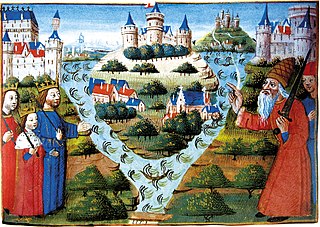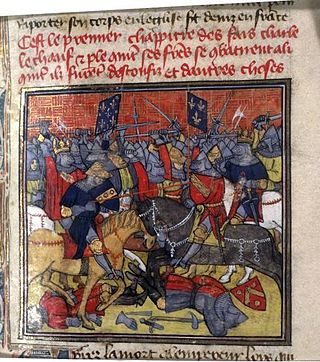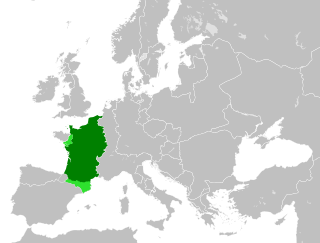
Louis the Pious, also called the Fair and the Debonaire, was King of the Franks and co-emperor with his father, Charlemagne, from 813. He was also King of Aquitaine from 781. As the only surviving son of Charlemagne and Hildegard, he became the sole ruler of the Franks after his father's death in 814, a position that he held until his death except from November 833 to March 834, when he was deposed.

The Treaty of Verdun, agreed in August 843, divided the Frankish Empire into three kingdoms between Lothair I, Louis II and Charles II, the surviving sons of the emperor Louis I, the son and successor of Charlemagne. The treaty was concluded following almost three years of civil war and was the culmination of negotiations lasting more than a year. It was the first in a series of partitions contributing to the dissolution of the empire created by Charlemagne and has been seen as foreshadowing the formation of many of the modern countries of western Europe.

The Carolingian dynasty was a Frankish noble family named after Charles Martel and his grandson Charlemagne, descendants of the Arnulfing and Pippinid clans of the 7th century AD. The dynasty consolidated its power in the 8th century, eventually making the offices of mayor of the palace and dux et princeps Francorum hereditary, and becoming the de facto rulers of the Franks as the real powers behind the Merovingian throne. In 751 the Merovingian dynasty which had ruled the Franks was overthrown with the consent of the Papacy and the aristocracy, and Pepin the Short, son of Martel, was crowned King of the Franks. The Carolingian dynasty reached its peak in 800 with the crowning of Charlemagne as the first Emperor of the Romans in the West in over three centuries. Nearly every monarch of France from Charlemagne's son Louis the Pious till the penultimate monarch of France Louis Philippe have been his descendants. His death in 814 began an extended period of fragmentation of the Carolingian Empire and decline that would eventually lead to the evolution of the Kingdom of France and the Holy Roman Empire.

The three-year Carolingian Civil War culminated in the decisive Battle of Fontenoy, also called the Battle of Fontenoy-en-Puisaye, fought at Fontenoy, near Auxerre, on 25 June 841. The war was fought to decide the territorial inheritances of Charlemagne's grandsons—the division of the Carolingian Empire among the three surviving sons of Louis the Pious. Despite Louis' provisions for succession, war broke out between his sons and nephews. The battle has been described as a major defeat for the allied forces of Lothair I of Italy and Pepin II of Aquitaine, and a victory for Charles the Bald and Louis the German. Hostilities dragged on for another two years until the Treaty of Verdun, which had a major influence on subsequent European history.

Lothair I was a 9th-century Carolingian emperor and king of Italy (818–855) and Middle Francia (843–855).
Nithard, a Frankish historian, was the son of Charlemagne's daughter Bertha. His father was Angilbert.

East Francia or the Kingdom of the East Franks was a successor state of Charlemagne's empire ruled by the Carolingian dynasty until 911. It was created through the Treaty of Verdun (843) which divided the former empire into three kingdoms.
Ermoldus Nigellus, or Niger—translated Ermold the Black, or Ermoald, was a poet who lived at the court of Pippin of Aquitaine, son of Frankish Emperor Louis I, and accompanied him on a campaign into Brittany in 824. Ermoldus was a cultured man with a knowledge of the Latin poets, and his poem, In honorem Hludovici imperatoris, has some historical value. It consists of four books and deals with the life and exploits of Louis from 781 to 826. He also wrote two poems in imitation of Ovid, which were addressed to Pippin.

In medieval historiography, West Francia or the Kingdom of the West Franks constitutes the initial stage of the Kingdom of France and extends from the year 843, from the Treaty of Verdun, to 987, the beginning of the Capetian dynasty. It was created from the division of the Carolingian Empire following the death of Louis the Pious, with its neighbor East Francia eventually evolving into the Kingdom of Germany.
A planctus is a lament or dirge, a song or poem expressing grief or mourning. It became a popular literary form in the Middle Ages, when they were written in Latin and in the vernacular. The most common planctus is to mourn the death of a famous person, but a number of other varieties have been identified by Peter Dronke. The earliest known example, the Planctus de obitu Karoli, was composed around 814, on the death of Charlemagne.
The anonymous Saxon poet known as Poeta Saxo, who composed the medieval Latin Annales de gestis Caroli magni imperatoris libri quinque was probably a monk of Saint Gall or possibly Corvey. His Annales is one of the earliest poetic treatments of annalistic material and one of the earliest historical works to concentrate on Saxony. It is considered characteristic of the dénouement of the Carolingian Renaissance.
Peter of Pisa, also known as Petrus Grammaticus, was an Italian grammarian, deacon and poet in the Early Middle Ages. In 776, after Charlemagne's conquest of the Lombard Kingdom, Peter was summoned to the Carolingian court along with Paul the Deacon and Alcuin. Peter had originally taught at Pavia, in Italy. Peter of Pisa was asked to be Charlemagne’s primary Latin teacher. Peter’s poetry provides a personal look at the workings of the innermost sanctum surrounding Charlemagne. Peter’s grammar texts provide insight into the transformation Latin education underwent in this period.
The Versus de Verona, also Carmen Pipinianum or Rhythmus Pipinianus, was a medieval Latin poetic encomium on the city of Verona, composed during the Carolingian Renaissance, between 795 and 806. It was modeled on the Laudes Mediolanensis civitatis (c.738), which is preserved today only in a Veronese manuscript. The anonymous Versus have been ascribed to Pacificus, archdeacon at Verona from 803 until his death in 846, but this ascription is unlikely. The poem consists of thirty-three strophes and three verses.
Rythmusde Pippini regis Victoria Avarica, also known by its incipit as Omnes gentes qui fecisti, is a medieval Latin encomium celebrating the victory of King Pepin of Italy over the Avars in the summer of 796. It is associated with an experimental trend of the Carolingian Renaissance and, though its author, probably a cleric, is unknown, is associated with the Veronese "school" of poets, one of whom, at the same time, produced the Versus de Verona, praising the royal capital of Italy, where it and De Pippini were probably written.
The Planctus (de obitu) Karoli, also known by its incipit A solis ortu, is an anonymous medieval Latin planctus eulogising Charlemagne, written in accented verse by a monk of Bobbio shortly after his subject's death in 814. It is generally considered the earliest surviving planctus, though its melody is written in tenth-century neumes, one of the earliest surviving examples of this sort of musical notation. The poem has been translated into English by Peter Godman.
The Swan Sequence is an anonymous Carolingian-Aquitainian Latin poem sequence first written around 850. Its melody, Planctus cygni, was popular for some two centuries after its composition.
Moduin, Modoin, or Mautwin was a Frankish churchman and Latin poet of the Carolingian Renaissance. He was a close friend of Theodulf of Orléans, a contemporary and courtier of the emperors Charlemagne and Louis the Pious, and a member of the Palatine Academy. In signing his own poems he used the pen name Naso in reference to the cognomen of Ovid. From 815 until his death he was the Bishop of Autun.
Hunald II, also spelled Hunold, Hunoald, Hunuald or Chunoald, was the Duke of Aquitaine from 768 until 769. He was probably the son of Duke Waiofar, who was assassinated on the orders of King Pippin the Short in 768. He laid claim to the duchy following Pippin's death later that year, but his revolt was crushed by Pippin's eldest son, Charlemagne. Hunald fled to the Duchy of Gascony, but he was handed over to Charlemagne and put into captivity. Nothing more is heard of him.
Amulo Lugdunensis served as Archbishop of Lyon from 841 to 852 AD. As a Gallic prelate, Amulo is best known for his letters concerning two major themes: Christian–Jewish relations in the Frankish kingdom and the Carolingian controversy over predestination. He was ordained as archbishop in January 841.